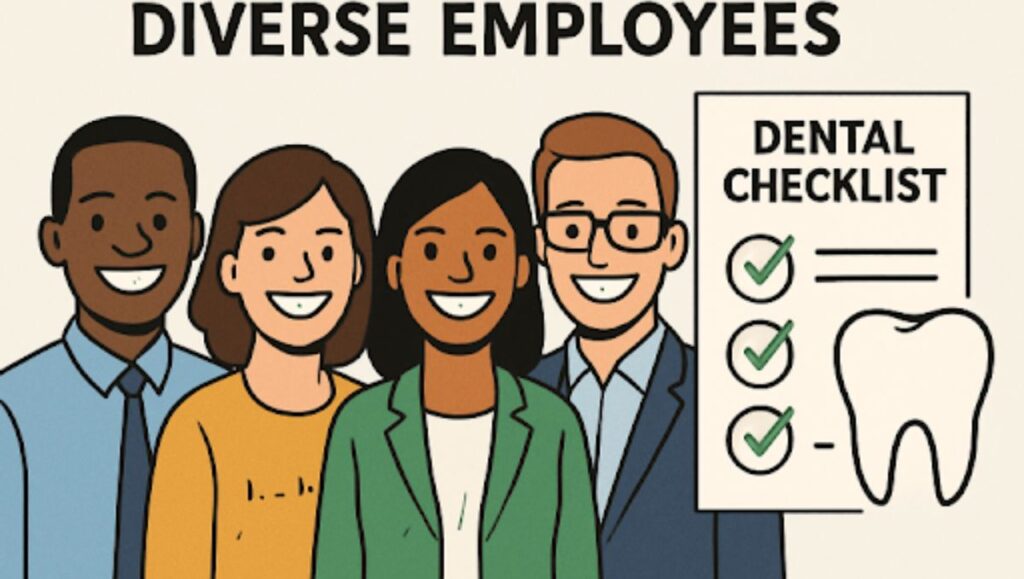Introduction
Offering robust dental benefits is a strategic advantage for organizations striving to build a competitive, employee-centric workplace. As today’s workforce puts a premium on health and well-being, fixing your benefits to meet employees’ needs is crucial. In particular, dental insurance ranks high among sought-after perks, second only to medical coverage for many workers. To make informed decisions about plan features and value, it’s essential to explore dental insurance comparisons and consider the blend of coverage, flexibility, and accessibility that resonates most with your team.
Effective dental plans do more than check a box on a benefits package—they actively promote employee satisfaction, foster retention, and can even improve productivity by reducing sick days due to oral health issues. As such, organizations committed to holistic wellness understand that a well-chosen dental plan serves the individual and the broader business objectives.
However, not all dental plans are created equal or offer the same value for employees at different life stages, health priorities, or family needs. Weighing the features of each plan type, along with employee feedback, is critical in delivering meaningful benefits that support diverse preferences and circumstances.
In addition to these considerations, modern dental coverage must adapt to digital expectations and eco-conscious mindsets. Contemporary employees increasingly expect their benefits to reflect innovation and responsibility, from technology-driven care options to sustainable dental product choices.
Understanding Employee Preferences
Recent surveys indicate that employees consistently name dental insurance as one of the most desired workplace benefits, often ranking it right behind medical insurance. This high ranking highlights how much employees value oral health and how coverage can elevate their overall job satisfaction. For employers, integrating dental insurance into the standard package communicates a commitment to employee well-being, which fuels higher morale and loyalty.
Diversifying plan designs to cater to various demographics in your workforce—such as offering coverage for families, orthodontics for dependents, and primary restorative services—can further ensure that employees feel supported across life stages. Developing benefit packages incorporating these broader needs often pays dividends in attraction and retention outcomes.
Emphasizing Preventive Care
Preventive dental care is the cornerstone of cost-effective coverage for employers and employees. Plans with full or high coverage for preventive services like cleanings, exams, and X-rays encourage regular visits and early intervention. Companies that nurture a culture of preventive care often observe a decrease in the number of claims for major, costly procedures—thereby lowering premiums over time and keeping employee out-of-pocket expenses in check.
Routine access to preventive services reduces dental problems and mitigates their impact on overall health. Poor oral health is linked to various medical conditions, including heart disease and diabetes. By championing preventive-focused plans, employers can help lower the total healthcare costs for their workforce and enhance long-term wellness outcomes.
Offering Flexible Plan Options
Diverse workforces demand flexibility in benefit options. Some employees may seek broad provider networks and greater freedom in a preferred provider organization (PPO). In contrast, others may value the affordability and simplicity of a Health Maintenance Organization (HMO) dental plan. Ensuring your dental benefits allow for this range of choices ensures employees can select what best aligns with their health needs and financial circumstances.
Consider offering plans with tiered levels—including basic, enhanced, and premium options—to accommodate varying preferences on coverage levels, deductibles, and annual maximums. Open enrollment periods offer the chance to gather feedback and adjust offerings, empowering employees to make informed choices each year as their needs evolve.
Integrating Dental and Vision Benefits
Bundling dental and vision insurance can amplify the attractiveness of your benefits package, providing a more holistic approach to employee health. Vision coverage is often the next most requested benefit after dental, addressing another vital aspect of personal well-being. By offering dental and vision options, employers support employees with comprehensive care for two essential facets of everyday health.
This integration can also streamline administration for HR departments and deliver cost efficiencies when both coverages are managed under a single provider. Employees appreciate the added convenience and value, making them more likely to take advantage of preventive screenings and maintain their overall health.
Considering In-House Membership Plans
For small businesses or those seeking creative alternatives to traditional insurance, in-house dental membership plans present a practical solution. These arrangements typically involve a monthly or annual fee that grants employees access to preventive services—such as cleanings, exams, and X-rays—often at no additional cost, while offering discounted rates for other procedures like fillings and crowns.
In-house plans can fill the gaps where conventional insurance might fall short, especially in local markets or industries with high part-time or contract workforces. By making dental care more accessible and budget-friendly, employers can boost participation and satisfaction among employees who might otherwise go uninsured.
Leveraging Technology and Sustainability
The digital transformation of healthcare now extends to dental benefit plans, with innovations like AI-based virtual dental consultations and mobile claim management platforms. These advancements increase accessibility and engagement, making dental care easier to schedule, track, and manage. Employees value intuitive digital tools that simplify appointments, benefits enrollment, and reminders for preventive care.
Additionally, offering options such as digital ID cards, paperless statements, and partnerships with eco-conscious dental supply providers can align your benefits program with sustainability-minded employees. As environmental awareness grows in the workforce, providing sustainable dental care options can become a meaningful differentiator for your business.
Conclusion
Selecting dental plan features that match your employees’ needs requires more than simply comparing coverage limits and premiums. Employers must consider preventive care, plan flexibility, integration with vision benefits, and innovative offerings encompassing digital and sustainable choices. When executed thoughtfully, robust dental benefits become a cornerstone of a thriving workplace—fueling health, loyalty, and long-term satisfaction.






